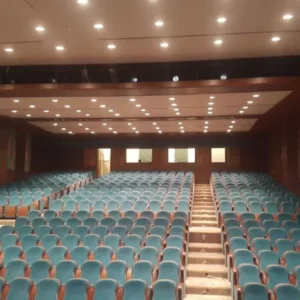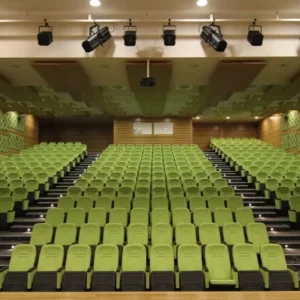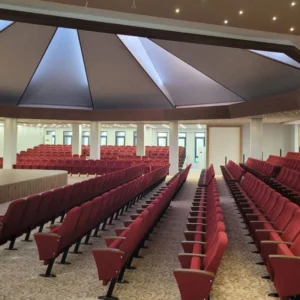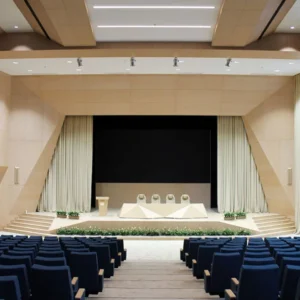When it comes to crafting spaces that blend functionality with long-term performance, commercial auditorium furniture isn’t just a detail—it’s a decision that defines the user experience and operational longevity of a venue. Whether you’re outfitting a new build or retrofitting an older hall, understanding the nuances of auditorium furniture systems can be a game-changer. If you’re part of the project team—architect, specifier, contractor, or buyer—you’re in the right place to dive deeper into what really matters.
Let’s explore how commercial-grade auditorium furniture shapes not only the physical space but also user engagement, maintenance dynamics, and even the ROI of large-scale venues.
Table of Contents
Understanding the Core: Commercial Auditorium Furniture
Commercial auditorium furniture refers to a specialized range of seating and furnishing solutions designed for high-traffic environments like theatres, conference halls, lecture spaces, and multi-use venues. These aren’t just chairs—they’re engineered systems crafted to endure constant use, maintain their integrity under pressure, and support architectural intentions.
But what exactly differentiates commercial auditorium seating from standard seating?
- Reinforced steel substructures
- Fire-retardant and wear-resistant fabrics
- Modular adaptability
- Integrated power/data options
- Silent auto-return mechanisms
These attributes aren’t just buzzwords—they’re the foundation of reliability and usability across thousands of seating cycles.
Have you ever wondered how many seating cycles a typical commercial auditorium chair endures in its lifetime? In many high-traffic venues, that number easily crosses 1 million operations over 10-15 years. That’s why durability isn’t optional—it’s essential.
Commercial Auditorium Seating: Built for High Performance
When choosing commercial auditorium seating, project teams often face a crossroads between aesthetic appeal and mechanical resilience. But let’s cut through the fluff: in commercial settings, performance takes precedence.
Engineering Behind Longevity
Manufacturers invest heavily in R&D to create seating systems that minimize maintenance. Key features include:
- High-density polyurethane cushioning
- Anti-sway mechanisms to reduce lateral movement
- Load-bearing legs engineered for concrete or raised flooring systems
- Mounting systems that allow both floor-fixed and beam-mounted variations
What many project managers overlook is the integration timeline. Fast-track projects benefit greatly from pre-assembled systems and simplified anchoring templates.
Acoustic Considerations
Another key design feature? Acoustic balance. Auditorium seating design must factor in how empty chairs absorb sound. Auditorium seating design isn’t only about comfort—it directly affects acoustical modeling and post-installation tuning.
Auditorium Furniture for Businesses: Versatility Across Sectors
Auditorium furniture for businesses spans more than theatres and schools. Think corporate campuses, government institutions, healthcare conferences, and even high-capacity training centers.
Flexible Configuration Possibilities
Today’s commercial venues often demand multi-purpose spaces. This has led to growing demand for:
- Stackable or removable seating modules
- Foldable desks for training or lectures
- Under-seat storage options
- Integrated aisle lighting systems for safety compliance
How do businesses benefit from modular commercial seating solutions? They gain the ability to transform static spaces into dynamic environments, hosting everything from TED-style talks to all-hands meetings and hybrid events.

Professional Auditorium Chairs: Beyond Appearance
Let’s talk precision. Professional auditorium chairs must meet strict technical requirements—because these seats don’t just serve audiences, they serve the building’s long-term operational strategy.
Standards and Specifications Matter
Procurement teams and architects consistently reference auditorium furniture specifications when comparing models. These may include:
- ANSI/BIFMA durability standards
- Flame-retardant certifications (such as EN 1021 or CA TB117-2013)
- Load-bearing capacity (typically 120–150 kg / 265–330 lbs)
- Compliance with accessibility standards (ADA or EN 16537)
How can you ensure your seating system passes final site inspections with flying colors? Engage with suppliers early and request certification documents in advance. Don’t wait until commissioning day.
Commercial Theatre Seating: Where Design Meets Audience Dynamics
In performing arts centers, commercial theatre seating plays a crucial role in both viewer immersion and spatial choreography. Rows must follow radial or serpentine layouts, and sightline studies often influence every millimeter of seat height.
Customization for Branding and Identity
Many cultural venues opt for fully customized seating finishes—ranging from laser-engraved row numbers to color schemes that match interior design themes. But customization doesn’t stop at color. Armrest materials, fabric texture, and even recline tension can be customized per project brief.
Is customization worth the lead time it adds to the project? If the venue’s identity is part of the brand experience, absolutely. For flagship spaces, it becomes a storytelling element that extends into every visitor interaction.
Institutional Auditorium Furniture: Compliance Meets Longevity
When equipping government facilities, universities, or large public halls, institutional auditorium furniture must tick off three primary concerns: safety, compliance, and lifecycle cost.

Procurement Challenges and Best Practices
Public projects often require transparent bidding processes and long-term supplier commitments. For these, partnering with commercial furniture suppliers who have a proven track record in public-sector tenders can streamline approvals.
Procurement documentation should cover:
- Detailed technical drawings
- Fire resistance reports
- Warranty periods (ideally 10+ years)
- Local installation teams or certified global installers
How can public institutions future-proof their seating investments? Prioritize furniture systems with replaceable components—armrests, seat pans, fabric sleeves—so maintenance doesn’t mean full replacement.
Materials That Define Performance
Auditorium furniture materials are no longer limited to plywood and basic foam. Today’s seating structures involve a marriage of metals, composites, engineered wood, and advanced polymers.
Common material components include:
- Powder-coated steel or aluminum frames
- Molded ABS or polypropylene shells
- Fire-rated upholstery foams with antimicrobial treatments
- Recycled content for LEED/BREEAM compliance
Material selection directly impacts cleaning protocols, acoustic properties, and even insurance premiums. For healthcare-adjacent venues, antimicrobial fabric treatments are now a minimum standard.
Staying Ahead: Commercial Furniture Trends
The last few years have transformed how commercial spaces are used. As a result, commercial furniture trends now reflect a hybrid between digital and physical user experiences.
Emerging trends include:
- Integrated USB-C and wireless charging pads
- QR-coded seat IDs for facility management
- AI-based occupancy sensors
- Upholstery options designed for antiviral resistance
What’s Next?
With AI-driven space planning tools and AR product previews on the rise, decision-makers are demanding more from suppliers—real-time customization tools, BIM-compatible files, and VR-ready 3D models.
Will AI and digital tools change how commercial seating is specified? They’re already doing it. The question is whether suppliers and architects are ready to collaborate on that next level of interaction.
Seamless Integration: Auditorium Furniture Installation
Even the best product fails without proper execution. Auditorium furniture installation requires synchronized workflows between civil teams, flooring contractors, and seating suppliers.
Best practices include:
- Pre-installation site surveys
- Template-based anchoring systems
- Installation phasing aligned with MEP and lighting schedules
- Post-installation testing for recline and return mechanisms
Why do many project delays happen during installation? Incomplete subfloor prep or misaligned anchor layouts. Double-checking layout drawings against on-site markings saves hours, if not days.










